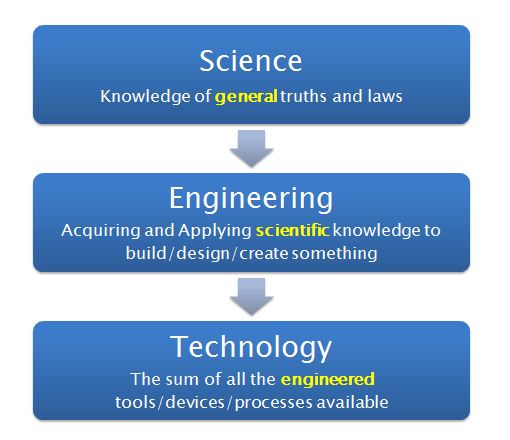Let’s delve into a fascinating conversation! Have you ever wondered about the nuanced differences between Science, Engineering, and Technology? While these fields overlap and intersect in many ways, they each have their unique characteristics and applications. Science, the grand pursuit of understanding the natural world; Engineering, the practical application of scientific principles; and Technology, the tangible result of these applications. Join us as we unravel the distinctions of these three interconnected, yet distinct, pillars of human knowledge and progress.
1. Brief Overview of Science, Engineering, and Technology
- Science is fundamentally about curiosity and exploration. It is the systematic study of the structure and behavior of the physical and natural world through observation and experiment. Distinct branches of science include physics, chemistry, biology, and many others. Each branch aims to explain a certain aspect of life or the universe and the foundational laws that govern them.
- Engineering, on the other hand, is about problem-solving. It is the application of scientific knowledge for practical purposes, often directly related to human life. Engineers design, build, and optimize everything around us, from the structures we live in, to the transport we use, to the tech devices we can’t live without.
- Technology is the bridge between science and engineering. It is the application of knowledge for the creation and optimization of practical things. It’s the laptop you’re reading this blog on, the app you use to order food, the renewable energy systems providing power to our homes, and so much more. Technology is the tangible outcome of applied scientific principles made possible by engineering.
Here are ten brief distinctions between Science, Engineering, and Technology:

Science, Engineering, and Technology are often confused with each other. All three are closely related but mean different things. In this post, we have tried to bring out the differences between science, engineering, and technology. Let’s start with a quote that brings out the difference between Science & Engineering:
“Scientists study the world as it is; engineers create the world that has never been.”
—Theodore von Kármán
In the above quote, we can clearly see the difference as well as the interconnection between science, engineering, and technology. This can be explained using the image that follows:
Now that we know the basic definitions and the overall comparison between the three, let’s move to a set of alternate differences between them. The differences below may seem redundant, and that’s because they are. They are all different ways of saying the same thing. Choose whichever appeals you the most:
1. Science is knowledge of the natural world put together, Engineering is creation based on the scientific knowledge put together, and Technology is the set of engineered creations put together.
2. Science comes from observation of the world, Engineering comes from aquiring and applying knowledge, and Technology comes from repeated application and approval of the engineered tools.
3. Science is about creating meaning of natural phenomenon, Engineering is about creating new devices, tools and processes, and Technology is about creating a collection of engineered and tested tools for the mankind.
2. Science

At its core, Science is a systematic enterprise that constructs and organizes knowledge in the form of testable explanations and predictions about the universe. It aims to create knowledge, specifically the knowledge of the natural world and the rules that govern it. Science strives to explain phenomena objectively and accurately, often through meticulous observation, experimentation, and analysis. Its purpose is to increase our understanding of the world around us, providing answers to the ‘why’ and ‘how’ of natural events, thus contributing to the body of human knowledge.
The Scientific Method and Its Importance
The scientific method is an essential tool in the arsenal of science. It is a systematic and logical approach to discovering how things in the universe work. The process typically begins with observations about the natural world. Scientists then propose hypotheses to explain these phenomena, and test the predictions following from those hypotheses through experiments. The results either support or contradict the hypotheses. This method improves the consistency and reliability of findings, making science a discipline of reproducible and verifiable knowledge.
The scientific method is crucial for its role in the pursuit of knowledge. Its rigorous procedures ensure that science stays objective and factual, preventing distortion of results due to biases. Moreover, it encourages critical thinking and curiosity, key traits for any scientist. Without the scientific method, science as we know it would not exist, and our understanding of the natural world would be significantly limited. It is, therefore, an indispensable component of scientific investigation.
Examples and Impact on Society
Science has profoundly shaped our world, from the fundamental understanding of natural phenomena to the development of modern technologies. For example, the scientific understanding of microorganisms has led to advancements in medicine, such as antibiotics and vaccines. These have dramatically increased our lifespan and quality of life. Climate science, on the other hand, provides insights into global warming’s impacts, informing policy decisions aimed at environmental preservation.
The societal impact of science is equally significant. It fosters a society that values evidence-based decision-making, critical thinking, and intellectual curiosity. It encourages us to question, explore, and understand the world around us. Furthermore, scientific knowledge empowers us to tackle global challenges, such as disease outbreaks, climate change, and food security. In this way, science is not just a collection of facts; it is a way of thinking that shapes our society and our future.
ALSO CHECK OUT OUR OTHER ARTICLES
- How to Cancel an Amazon Order and Get a Refund? Best Guide
- How To Convert Load To Gcash (Step-by-step Guide in 2023)
- How to Increase tweets impression using Useviral
- Step-by-step Guide on How to Transfer Google Drive to Another Account
- Complete Guide on How to Cash-in in GCash – 2023
3. Engineering

Engineering is the application of scientific knowledge to solve practical problems. It involves designing, building, and maintaining structures, machines, devices, systems, materials and processes. The work of engineers is grounded in practicality, seeking solutions that are efficient, effective, and sustainable. The purpose of engineering is to harness the principles and theories of science and make them useful to society. Engineers transform the abstract concepts of scientists into tangible, usable technologies and infrastructures. This discipline extends to various fields, including but not limited to mechanical, civil, electrical, and chemical engineering. Each of these fields uses scientific understanding differently to solve specific types of problems. As such, engineering is a critical link between scientific discovery and real-world application.
The Engineering Design Process
The Engineering Design Process is a series of steps that engineers follow to come up with a solution to a problem. It begins with identifying the problem – understanding its nature, its scope, and its impact. This is followed by research, where engineers delve into existing solutions, if any, and identify areas of improvement. The next step involves brainstorming and designing a solution. This is a creative process where engineers conceptualize potential solutions and develop detailed plans. The plans are then brought to life in the next step – building a prototype. The prototype undergoes rigorous testing, and based on the results, is iteratively refined and improved. The final step is the implementation of the solution – the product is manufactured on a large scale and introduced to the market. This process may seem linear, but in practice, it is dynamic and iterative, with constant feedback and improvement at every stage. In this way, the Engineering Design Process is a testament to the problem-solving ethos of engineering.
Examples and Impact on Society
Engineering has shaped our society in myriad ways. For instance, civil engineers design infrastructure such as roads, bridges, and buildings, essentially constructing the physical environment in which we live. Electrical engineers, on the other hand, have revolutionized the way we communicate and interact with the world through the creation and advancement of telecommunication systems and consumer electronics.
The societal impact of these innovations is profound. Infrastructure improvements have facilitated trade and transportation, enabling economic growth, while advances in telecommunications have shrunk the world, making it possible to connect with people and access information instantaneously from virtually anywhere. These advancements, born out of the engineering design process, have enhanced the quality of life for individuals worldwide.
Moreover, engineering also tackles some of society’s greatest challenges. Environmental engineers work on solutions for waste management, water treatment, and pollution control, playing a pivotal role in sustaining our planet. Biomedical engineers contribute to the healthcare sector through the development of medical equipment, prosthetics, and therapeutic strategies, enhancing patient care and treatment outcomes.
In summary, engineering’s impact on society is multifaceted and far-reaching, illustrating the tangible ways science is applied through engineering to solve real-world problems and improve lives.
4. Technology

Technology can be defined as the application of scientific and engineering knowledge to create devices, systems, and procedures that fulfill a certain purpose or solve a problem. It is essentially the practical output of scientific and engineering principles, packaged in a form that can be utilized by society. The ultimate purpose of technology is to enhance efficiency, productivity, and overall quality of life. It spans various fields from communication and transportation to healthcare and entertainment. In essence, technology is the tool that transforms scientific ideas into practical, usable solutions that help in making our lives easier, safer, and more comfortable.
The Role of Technology in Integrating Science and Engineering
Technology acts as the bridge between science and engineering, making it a crucial component of this triad. It translates the theoretical principles of science into practical applications through engineering. In this process, the role of technology is dual-natured. On one hand, it is the end product of the successful application of science through engineering. On the other hand, it is also the catalyst that drives further scientific exploration and engineering innovation.
For instance, the technology in advanced scientific equipment allows for more precise observation and measurement, leading to new scientific discoveries. Those discoveries in turn inspire engineers to develop new technologies. This cyclical relationship between science, engineering, and technology ensures continuous progress and innovation.
In terms of societal impact, technology integrates the wonders of science and the practicality of engineering to solve real-world problems. It is through technology that we can see the tangible results of scientific theories and engineering designs, impacting every aspect of our daily lives, from healthcare and transportation to communication and entertainment. In summary, technology is the linchpin that connects science and engineering, facilitating a symbiotic relationship that propels humanity forward.
Examples and Impact on Society
One of the most impactful examples of technology bridging science and engineering is the development of medical devices. For instance, Magnetic Resonance Imaging (MRI) technology, a product of advances in both physics (science) and electrical and software engineering, has revolutionized diagnostics, enabling doctors to examine the human body’s interior without surgery. Likewise, the development of the Internet, a combined feat of computer science and engineering, has dramatically reshaped society, affecting everything from communication and business to education and entertainment.
Another profound example is the evolution of space technology. The scientific theories of astrophysics and quantum mechanics, combined with advanced engineering, have allowed for the creation of satellites, spacecraft, and the International Space Station. These technologies have not only furthered our understanding of the universe but also have practical applications, such as GPS for navigation and weather prediction.
In essence, every technological innovation, whether it be smartphones, electric cars, or green energy solutions, represents the symbiosis of science and engineering. Through these examples, we witness how technology, as a bridge between science and engineering, has a far-reaching impact on society, contributing to our progress and improving the quality of life.
5. Interplay Between Science, Engineering, and Technology

How Science, Engineering, and Technology Inform and Influence Each Other
Science, engineering, and technology are three pillars that essentially drive each other forward in a synergistic relationship. Science, the pursuit of understanding the natural world, often poses questions and uncovers truths that plant the seeds for technological innovation. It is the theoretical bedrock upon which technology is built, providing the principles and laws that define what is possible.
Engineering, on the other hand, is the practical application of scientific knowledge. Engineers take the theories and principles uncovered by science and find ways to implement them, crafting solutions to real-world problems, and often pushing the boundaries of what is known in the process.
Technology represents the successful implementation of these theories and principles into tools, systems, and processes that impact our daily lives. It is the tangible manifestation of both science and engineering and its development often raises new questions or challenges, feeding back into the scientific process and starting the cycle anew.
In this manner, science informs technology by providing knowledge about the universe and the laws it operates under, engineering applies this knowledge in practical ways, and technology provides new challenges and questions for science to explore and engineering to resolve. This interplay creates a cycle of mutual advancement, pushing each field—and society as a whole—forward.
Examples of This Interplay in the Real World
Consider the development of space exploration. Scientific discoveries about the nature of our universe, such as the understanding of gravity and planetary orbits, set a foundation for the field. Engineers then leveraged this knowledge to design and build spacecraft, using principles of aerodynamics, materials science, and computer technology. This technological achievement, in turn, opened up a whole new frontier for scientific inquiry, prompting further questions about the existence of life on other planets, the composition of celestial bodies, and the origins of the universe. Another example can be seen in the evolution of computer technology. Theoretical research in mathematics and logic laid the groundwork for the development of computer programming. Engineers then applied these principles to build hardware capable of executing these programs. As technology became more advanced, it presented new challenges that required further scientific investigation and engineering solutions, such as the development of quantum computing.
Conclusion
In the final analysis, science, engineering, and technology are distinct yet deeply interlinked disciplines, each driving the other in a perpetual cycle of discovery, innovation, and advancement. Science provides us with insight into the laws of the universe, engineering applies this knowledge to solve practical problems, and technology sets new challenges for both science and engineering. This intricate interplay, as seen through real-world examples like space exploration and computer technology, underscores the importance of integrated thinking and collaboration among these fields. Moving forward, it’s crucial that we continue fostering a symbiosis between science, engineering, and technology, as it propels us toward a future filled with untold potential and progress.





1 Comment
Pingback: An Introduction to Humanoids